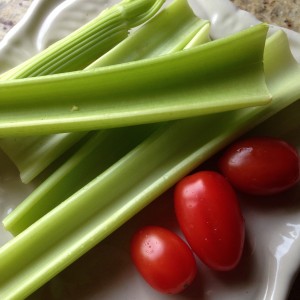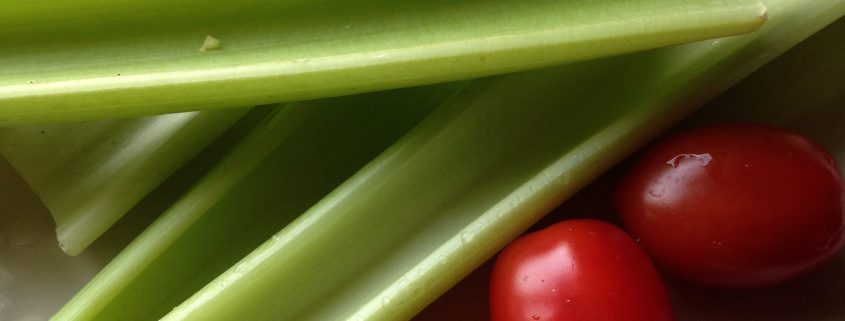Celery Celebration
 As far back as the ancient Greeks, celery has been used as an ingredient in many dishes. It is an incredibly versatile ingredient that can serve as the base of the dish or as an addition for more of a crunch. Since it’s available year-round at a reasonable cost, it’s an ingredient that won’t hurt your wallet, either.
As far back as the ancient Greeks, celery has been used as an ingredient in many dishes. It is an incredibly versatile ingredient that can serve as the base of the dish or as an addition for more of a crunch. Since it’s available year-round at a reasonable cost, it’s an ingredient that won’t hurt your wallet, either.
Luckily, April is National Fresh Celery Monthand it’s the perfect time to learn more about this delicious vegetable!
From Seeds to Roots
All parts of the typical celery plants grown in the United States can be eaten, from roots to stems to seeds.
Celery seeds are an acquired taste. They taste like very concentrated celery, so it’s best to use them sparingly. These seeds can be used whole in homemade breads, like caraway seeds, or ground in a spice grinder and added to onion and garlic powder for a delicious dry rub for steaks or chicken.
Celery root is exactly what it sounds like, the root of the celery plant. It’s also known as celeriac and is usually carried in specialty grocery stores. For the most part you can treat celeriac as you would any root vegetable, like potatoes. However, the skin is inedible, so be sure to peel it before roasting. Roast the root with olive oil and a little salt and pepper for a delicious side dish.
Ribs and leaves are what most people are used to using on a regular basis. They can be eaten cooked or raw in a wide range of applications. They are one of the vegetables that make up mirepoix, a mix of finely diced vegetables, usually two parts onions, one part carrots, and one part celery, which form the base of many soups and stews.
Celery and Nutrition
Celery is made up primarily of water, so it’s a great snack to crunch on during those warm summer months. One cup of diced celery only contains 16 calories and contains 2 grams of fiber, most of which is insoluble, which makes it a great way to keep your digestive system moving well. Celery also contains:
- Vitamin K, which plays an important role in bone health and blood clotting.
- Folate, which is especially important in women of childbearing age. Folate plays a key role in your nervous system, and is critical in ensuring proper fetal neural development.
- Potassium, which works together with sodium in regulating blood pressure. Too much sodium can raise blood pressure, so eating foods like celery, which is high in potassium, can help excrete sodium, which in turn lowers your blood pressure.*
*I often get asked if celery should be avoided if someone is on a low sodium plan. The answer is no. While celery does have a higher sodium content compared to other vegetables, it is not a high sodium food.
Celery is most nutritious right after harvesting, so it’s best to use it quickly once you buy it. Store unused celery wrapped tightly in aluminum foil for up to a month.
Celery Snack and Meal Ideas
Celery is a versatile vegetable that can be paired with almost anything. It’s refreshing and crunch qualities make it worthy of being the main vegetable instead of an afterthought when eating wings. Here are 4 ways you can eat more celery:
1. Celery and Peanut Butter. The combination of smooth peanut butter with a crunchy vegetable is very appetizing. Add raisins on top for a delicious snack. You can also top it with hummus or low-fat cream cheese!
2. Celery and Vegetable Stock. Braise celery in low-sodium vegetable stock and then season it with your favorite herbs and spices, such as parsley, basil, paprika, dill and curry. This makes for a quick, low-calorie, delicious side dish. You can get creative with how you flavor it!
3. Celery and Stews. Add chopped or whole stalks into your favorite stew. When it cooks, the liquid will soften the stalk, creating a flavorful meal.
4. Celery and Salads. Chopped celery can be mixed into tuna and chicken salad, garden salad, Greek salad, or whatever salad you want to eat! Its crunchy texture is consistent with the rest of the salad, which makes this a great match.
Depending on what part of the celery you are using, you can dial the volume up or down; the inner heart and leaves have the most concentrated flavor!
It’s time to pick up some celery from the store today and get cooking to celebrate this delicious vegetable.
Your Turn to Take Action:How will you try celery this month? Let me know in the comments below!


Leave a Reply
Want to join the discussion?Feel free to contribute!